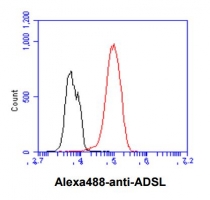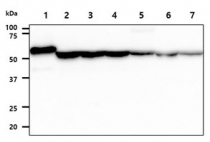ARG57062
anti-ADSL / Adenylosuccinate Lyase antibody [16C10]
anti-ADSL / Adenylosuccinate Lyase antibody [16C10] for Flow cytometry,Western blot and Human
Overview
| Product Description | Mouse Monoclonal antibody [16C10] recognizes ADSL / Adenylosuccinate Lyase |
|---|---|
| Tested Reactivity | Hu |
| Tested Application | FACS, WB |
| Host | Mouse |
| Clonality | Monoclonal |
| Clone | 16C10 |
| Isotype | IgG1, kappa |
| Target Name | ADSL / Adenylosuccinate Lyase |
| Antigen Species | Human |
| Immunogen | Recombinant fragment around aa. 1-484 of Human ADSL / Adenylosuccinate Lyase. |
| Conjugation | Un-conjugated |
| Alternate Names | ASASE; ASase; EC 4.3.2.2; Adenylosuccinase; Adenylosuccinate lyase; AMPS; ASL |
Application Instructions
| Application Suggestion |
|
||||||
|---|---|---|---|---|---|---|---|
| Application Note | * The dilutions indicate recommended starting dilutions and the optimal dilutions or concentrations should be determined by the scientist. |
Properties
| Form | Liquid |
|---|---|
| Purification | Purification with Protein A. |
| Buffer | PBS (pH 7.4), 0.02% Sodium azide and 10% Glycerol. |
| Preservative | 0.02% Sodium azide |
| Stabilizer | 10% Glycerol |
| Concentration | 1 mg/ml |
| Storage Instruction | For continuous use, store undiluted antibody at 2-8°C for up to a week. For long-term storage, aliquot and store at -20°C. Storage in frost free freezers is not recommended. Avoid repeated freeze/thaw cycles. Suggest spin the vial prior to opening. The antibody solution should be gently mixed before use. |
| Note | For laboratory research only, not for drug, diagnostic or other use. |
Bioinformation
| Database Links | |
|---|---|
| Gene Symbol | ADSL |
| Gene Full Name | adenylosuccinate lyase |
| Background | Adenylsuccinate lyase is involved in both de novo synthesis of purines and formation of adenosine monophosphate from inosine monophosphate. It catalyzes two reactions in AMP biosynthesis: the removal of a fumarate from succinylaminoimidazole carboxamide (SAICA) ribotide to give aminoimidazole carboxamide ribotide (AICA) and removal of fumarate from adenylosuccinate to give AMP. Adenylosuccinase deficiency results in succinylpurinemic autism, psychomotor retardation, and , in some cases, growth retardation associated with muscle wasting and epilepsy. Two transcript variants encoding different isoforms have been found for this gene. [provided by RefSeq, Jul 2008] |
| Function | Catalyzes two non-sequential steps in de novo AMP synthesis: converts (S)-2-(5-amino-1-(5-phospho-D-ribosyl)imidazole-4-carboxamido)succinate (SAICAR) to fumarate plus 5-amino-1-(5-phospho-D-ribosyl)imidazole-4-carboxamide, and thereby also contributes to de novo IMP synthesis, and converts succinyladenosine monophosphate (SAMP) to AMP and fumarate. [UniProt] |
| Calculated MW | 55 kDa |
Images (2) Click the Picture to Zoom In
-
ARG57062 anti-ADSL / Adenylosuccinate Lyase antibody [16C10] FACS image
Flow Cytometry: Hep3B cell line stained with ARG57062 anti-ADSL / Adenylosuccinate Lyase antibody [16C10] at 2-5 µg for 1x10^6 cells (red line). Secondary antibody: Goat anti-Mouse IgG Alexa fluor 488 conjugate. Isotype control antibody was Mouse IgG (black line).
-
ARG57062 anti-ADSL / Adenylosuccinate Lyase antibody [16C10] WB image
Western blot: 1) 20 ng of Recombinant Protein, 40 µg of 2) HeLa cell lysate, 3) 293T cell lysate, 4) Jurkat cell lysate, 5) HepG2 cell lysate, 6) A549 cell lysate, and 7) MCF7 cell lysate stained with ARG57062 anti-ADSL / Adenylosuccinate Lyase antibody [16C10] at 1:1000.







